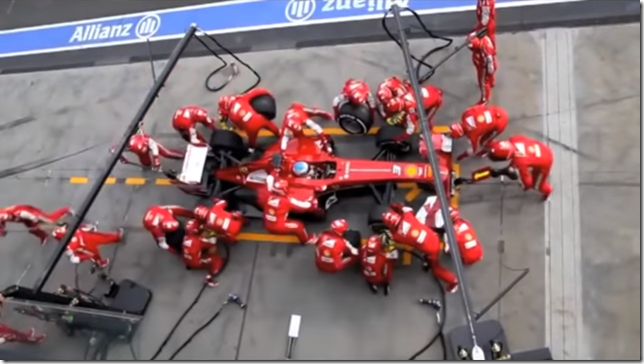I recently tweeted a video that compared a 1950’s pit stop to one from 2013 (DevOps before and after.). It received a couple of comments that challenged if the second pit stop although much faster really added value.

One comment pointed out that there are many more people in the second pit stop than in the first. I would argue that there are a lot more people involved in delivering software now than even a decade ago. Software delivery has become a team sport involving many more people than ever before. Which I feel is very clear in the video.
What I also found interesting is when I saw all the additional people I saw them as automated tasks in my head. Specialized tools used to achieve a common goal. They are like micro-services. One service to remove the tire, another to replace it and one service to just jack up the vehicle. I saw and incredibly orchestrated pipeline. I also noticed redundancy built in to the process. If you watch the back of the vehicle there are two people with jacks. One jacks up the back of the vehicle and the other appears to be there just in case. There are also people near the front on the far side that never touch the vehicle but are monitoring the process, so they can learn and improve.
Another comment points out that in the second pit stop the team does not refuel the vehicle. I believe you should fix what hurts most first. Watch the first pit stop again. Refueling the vehicle is done long before the second tire is changed. Reviewing the first pit stop what hurt most was the tire changing. The first pit stop took over 60 seconds the second less than 2. Even if they had refueled the vehicle at the same rate as the 1950’s pit stop that would have been an enormous gain. Not to mention in the second pit stop they changed all four tires and not just two.
I also think it is important to realize that the second team was not required to refuel the vehicle. This means work has already been done to remove the need for the bottle neck by making the vehicles more efficient. We do this in software. Historically manual testing has been the bottle neck, so many teams are leveraging automated tests to reduce the need for manual testing. Applications are being re-architected so the majority of the functionally can be tested and verified in a much more efficient way. This does not remove the bottle neck entirely because at some point manual test might still be run. However, the number of tests should be reduced and therefore the time to execute is reduced as well. Just as in the F1 race eventually the vehicle will need to be refueled but less frequently and quicker because they require less fuel.
The more I watch the video the more I think it is the perfect visualization of a digital transformation.